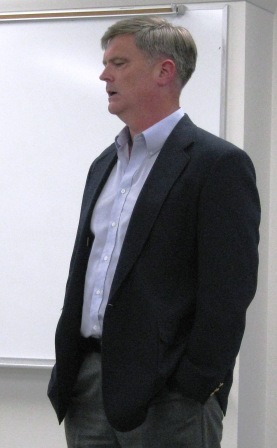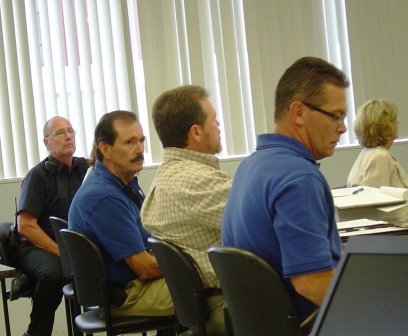Mary Potter
Tuesday, July 27, 2010 8:41 pm
|

Heltzel was at Murray State University today to launch the program. Hickman and Marshall County emergency management personnel and elected officials from those two counties are the first to work through an exhaustive series of objectives. Each county had its own computer program and screens. Each county filled in the blanks with their unique issues and answers. When completed, the program, which can used either by accessing an online database, on a laptop or in printed form, will guide responders and elected officials from first alert to recovery.
Emergency Management (EM) in each county is the lead agency when an emergency is declared. Kentucky has had seven disasters that rose to the level of a presidential declaration in the last two years. The most recent is the flooding in Pike County in far eastern Kentucky.
When the emergency is declared, responders must be notified, jobs assigned and emergency response centers set up. That may sound simple to do on a sunny day in July, but it is a greater challenge when it happens at two a.m. in February. Heltzel pointed out to participants that, unlike weather events, earthquakes occur without warning.
From first alert to full restoration, the program encourages emergency management leaders to avail themselves of assistance. When Hickman County Emergency Management put their agency into the lead role in successive objectives, state facilitators intervened. They pointed out that emergency managers can’t do everything. At some point you wear out, they were warned. The exercise pointed out the issue of small counties and the lack of resources they face when dealing with a mega disaster.
The program is not perfect. It can be repetitious and has more than its share of insider jargon. As the program gets beta tested across the Zone, improvements will be ongoing. On its very first day, participants had numerous good suggestions for programmers in attendance. Drop down menus and contact information as the mouse floats over agency names were duly noted.
In a meeting for elected officials held in the morning, General Heltzel told County Judge Greg Pruitt that the workshop is the first step in planning for an earthquake preparedness exercise in May 2011 involving federal, state and local officials from eight states. Heltzel is head of the consortium putting the May program together.
Heltzel’s aim is to establish a joint planning document so the county judges will know what the general is doing and the general will know what the county judges are doing in the critical early hours of a disaster. It is anticipated that at least forty eight hours will pass before the National Guard can assist.
Heltzel had some bad news for Judge Pruitt. The Corps of Engineers geological map shows soil liquefaction of 99% of his county. Out of 244 square miles, less than 400 acres remain solid in a major earthquake event. The original New Madrid Quake is estimated to be an 8 on the Richter scale.
This pattern is the same for the eight counties of the Jackson Purchase. That means that buildings that don’t fall down may sink into sand and water slurry. A worst case scenario is for an earthquake event to last from three months to two years. The New Madrid Quake of 1811-1812 lasted sixteen months. Aftershocks in some cases more intense than the initial shock continued for months.
The New Madrid Quake was the largest in American history. Most US residents, when asked to name the biggest quake in our history, will most often name the San Francisco Quake of 1906. The mistake is in part because reporting was significantly better in the early 1900s than in early 1800s. There was little loss of life in the New Madrid Quake. Settlers lived in one story log homes. If the quake destroyed them, the settlers either rebuilt or moved away. San Francisco’s quake and subsequent fire destroyed the city with the loss of thousands of lives. It is, for sure, the more memorable event.
But if New Madrid’s seismic zone fires up as it did in 1811, it will take back the title of biggest and baddest.
In West Kentucky alone, according to Heltzel, three thousand bridges will be affected. Six are major bridges that if damaged could stop relief by truck convoys. There is predicted to be a large loss of life. A big quake will affect the economy of the whole nation. Transmission lines broken in the quake area can darken the East Coast. Broken natural gas transmission pipelines through West Kentucky will cause hardship for half the nation.
What’s needed, General Heltzel told twenty people from two small West Kentucky counties, is public awareness and preparation. General Heltzel was asked by Hickman County Emergency Director Shadd Byassee if earthquakes in surrounding areas have any connection to the New Madrid Seismic Zone.
Heltzel answered that he has been tracking earthquakes around the world and around the US. “I can’t say they are related. But we are moving as fast as we can to get a plan in place,” was his rueful reply.

